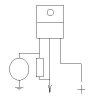AllanEuerby
New Member
I want to auto. dim a 7-segment display from an LM317 regulator via a light dependant resistor.
The display needs a maximum of 2V (daylight), minimum of about 1V(dark).
The LDR has resistances of about 600Kohm (bright light) to 400ohm (dark).
I don't want to use a 7-segment driver.
I've tried a few resistor combinations, but seem to be missing something...
Any ideas?
Allan.
The display needs a maximum of 2V (daylight), minimum of about 1V(dark).
The LDR has resistances of about 600Kohm (bright light) to 400ohm (dark).
I don't want to use a 7-segment driver.
I've tried a few resistor combinations, but seem to be missing something...
Any ideas?
Allan.



